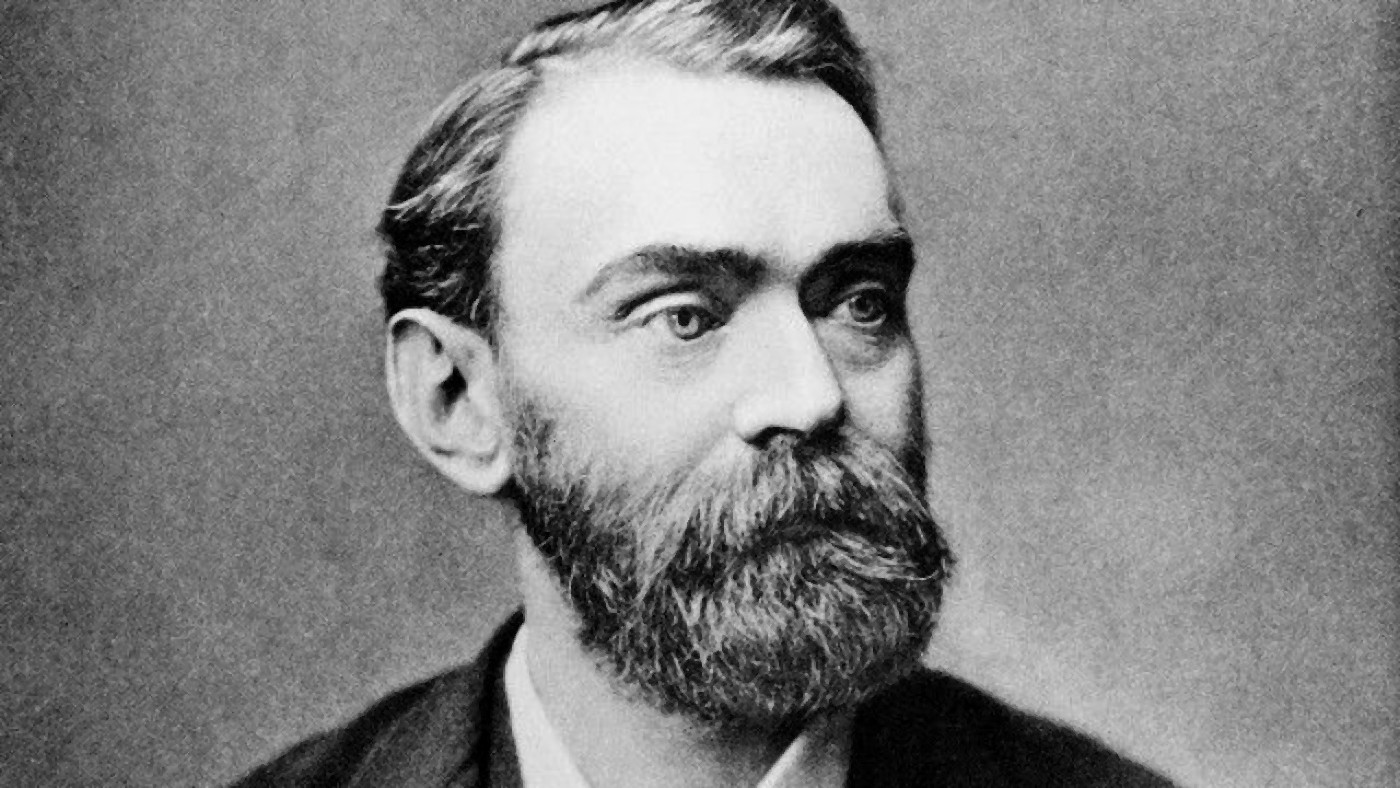Alfred Nobel was famous during his lifetime for inventing dynamite. This Swedish chemist, engineer and industrialist registered over 350 different patents and established a network of laboratories and factories for explosives in 20 countries around the world. In 1888 Alfred’s brother Louis died in France of a heart attack. At that time, the local newspapers printed Ludwik’s obituaries, and among them at least one was titled by mistake not Ludwik, but Alfred Nobel.
The article is a text version of one of the 15 episodes of the new season of the podcast “History You Do Not Know”. You can listen to it by launching the player below:
Its title was “Le marchand de la mort est mort” or “The Merchant of Death”, announcing that “Dr. Alfred Nobel died yesterday, who made a fortune looking for ways to kill as many people as possible as soon as possible.”
When Alfred read his obituary, he was horrified at the thought that he would be remembered this way. In his will, written a few years later, he allocated over 90% of his enormous fortune to create a fund to be distributed in the form of prizes for achievements in the field of physics, chemistry, medicine, literature or in the field of promoting the ideas of peace.
The irony of history is that since 1901 the Norwegian Nobel Committee has awarded the most prestigious award in the world – the Nobel Peace Prize – on each anniversary of the death of Alfred Nobel, who contributed significantly to the development of military technology and the escalation of arms in the 20th century. For Alfred was not only the inventor of dynamite, but also the designer of detonators and detonators that were used in all the wars of the last century. Despite this, he is known today primarily for the famous awards named after him.
But he was not the only one who instituted the patent for immortality
Andrew Carnegie, who grew up in a poor Scottish family, immigrated to the United States as a teenager. He started working in a cotton mill to produce more steel than Britain at the peak of his career. He was the richest person in the world and at the same time the personification of a capitalist bloodsucker. The day wage in his workplaces could last 12 hours, he did not recognize holidays, trade unions and strikes, and he paid the workers the lowest possible wages.
“For the first part of life, a person should accumulate wealth, and for the second – share it. Because whoever dies rich dies in shame, he used to say. In 1901, he retired from business and sold his companies for $ 400 million, or the equivalent of at least $ 20 billion today. Then he proceeded to share the wealth, allocating nearly 90% of his gigantic fortune to the construction of thousands of libraries, the University of Edinburgh, and the New York concert hall. It was he, at the age of 54, who wrote the “Gospel of Riches”, which is still considered to be an interpretation of philanthropy.
He gave each of the funded facilities his own surname. He named the concert hall in New York City Carnegie Hall, a museum complex in Pittsburgh the Carnegie Museum, and research in physics and biology was supported by his Carnegie Institution.
Princeton University received the most peculiar support. When the university president asked Carnegie to financially support American football, he replied that he hated the brutal sport, but could sponsor rowing. The rector agreed, and the philanthropist, to the widespread surprise of the university, did not hand over the boat, but … the lake on which the regatta course was built.
As he himself said, he followed the “Gospel of riches” which obliged him to return to society what he had taken. To this end, he followed the same business principles that made him rich.
Carnegie’s approach to philanthropy has grown in popularity. Over the next century, wealthy donors followed Carnegie’s footsteps honing the art of spending money on the common good. It was treated as a financial investment, and the richest collected donations for charity using the knowledge and skills they had acquired in business. Traditional donors had more modest goals and didn’t expect much in return for their generosity, unlike the new American philanthropy, which was a capitalist effort to improve society and… a way to be remembered.
Carnegie was followed, among others, by Rockefeller, who sold candies to his friends at the age of a few years, and got his first job as a 16-year-old
Like Andrew, John got rich from aggressive capitalism. The oil company Standard Oil he founded either took over or bankrupted weaker competitors. Many of them, in desperation, committed suicide.
At the turn of the 19th and 20th centuries, Rockefeller controlled approximately 90% of the oil market, and the value of its assets was estimated at almost 2% of the entire US national income.
As a Baptist, he gave the Church 10 percent. your income. Even so, he was America’s most hated entrepreneur. Although he did not show it in public, it is known today that he did not feel comfortable with it. He did not want to go down in history as the richest, but at the same time the most ruthless man of big business.
However, his first attempts to improve his reputation had been awkward to say the least. Everywhere he appeared, he handed out coins – silver coins to adults and nickel coins to children. In an attempt to make the thousands of people happy he encountered, he exposed himself to mockery from the press. Then he changed his strategy. He donated $ 80 million to the University of Chicago, which, however, went unnoticed. But established in 1901 in New York, the Institute of Medical Research named after Rockefeller could no longer go unnoticed. The institute raised 23 Nobel laureates, changing its name to Rockefeller University over time. We owe him to, among others yellow fever vaccine and medicines for meningitis.
Rockefeller’s accursed name with time ceased to be associated only with the desire for profit. But the path to this goal was not easy. When Rockefeller announced the establishment of a great charitable foundation in his name in 1913, US President William Taft hesitated to agree to it, fearing that “it was a project to legalize Mr. Rockefeller.” Samuel Gompers, an American trade union activist, was no longer so subtle when he declared: “The only thing that Mr. Rockefeller founded institutions can teach is what you shouldn’t do, lest you become like him.” However, the foundation was established, and until the Bill and Melinda Gates Foundation appeared, it was the largest philanthropic institution in the world. Thanks to this, today Rockefeller is synonymous with a rich man who inspires respect and admiration.
This understanding of philanthropy still finds its followers, especially in the United States
In August 2010, forty US billionaires, led by Warren Buffett and Bill Gates, announced that they would donate at least half of their fortune to charity. Like Nobel, Carnegie and Rockeffeler, they wish to leave a permanent mark on world history. Wherever you look, it seems that the great benefactors are pursuing extremely ambitious goals: they halt climate change, reform education, and eliminate dangerous diseases.
At the same time, foundations set up by billionaires are facing enormous criticism. According to The Atalntic, Zuckerberg and Chan’s “Non-Charity Charity” boils down to tax evasion and undemocratic seizure of power. Do they prioritize properly? Do they choose the best possible goals? Are they using money in the most efficient way?
Well, it remains to admit the economist Wesley Mitchell, who wrote in 1912 in the American Economic Review: “Spending money is easy, but spending money wisely is really hard.”
Andrzej Skasko / A story you don’t know















